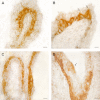Expression of orexin A and its receptor 1 in the human prostate
- PMID: 23425077
- PMCID: PMC3610039
- DOI: 10.1111/joa.12030
Expression of orexin A and its receptor 1 in the human prostate
Abstract
The peptides orexin A (OXA) and orexin B, deriving from the cleavage of the precursor molecule prepro-orexin, bind two G-coupled transmembrane receptors, named as receptor 1 (OX1R) and receptor 2 for orexin, showing different affinity-binding properties. First discovered in the rat hypothalamus, orexins and their receptors have been also found in many peripheral tissues where they exert neuroendocrine, autocrine and paracrine functions. Because inconclusive data on their localization in the mammalian prostate are reported, the aim of this study was to investigate the presence of prepro-orexin, OXA and OX1R in the human normal and hyperplastic gland. Immunohistochemistry revealed the localization of both OXA and OX1R in the cytoplasm of the follicular exocrine epithelium of all tested normal and hyperplastic prostates. Positive immunostaining was mainly observed in the basal cells of the stratified epithelium, and only rarely in the apical cells. The expression of mRNAs coding for prepro-orexin and OX1R and of proteins in the tissues was also ascertained by polymerase chain reaction and Western blotting analysis, respectively. In order to gain insights into the functional activity of OXA in the prostate, we administered different concentrations of OXA to cultured prostatic epithelial cells PNT1A. We first demonstrated that PNT1A cells express OX1R. The addition of OXA did not affect PNT1A cell proliferation, while it enhanced cAMP synthesis and Ca(2+) release from intracellular storage. Overall, our results definitely demonstrate the expression of OXA and OX1R in the human prostate, and suggest an active role for them in the metabolism of the gland.
© 2013 The Authors Journal of Anatomy © 2013 Anatomical Society.
Figures




References
-
- Ammoun S, Holmqvist T, Shariatmadari R, et al. Distinct recognition of OX1 and OX2 receptors by orexin peptides. J Pharmacol Exp Ther. 2003;305:507–514. - PubMed
-
- Assisi L, Tafuri S, Liguori G, et al. Expression and role of receptor 1 for orexins in seminiferous tubules of rat testis. Cell Tissue Res. 2012;348:601–607. - PubMed
-
- Barreiro ML, Pineda R, Navarro VM, et al. Orexin 1 receptor messenger ribonucleic acid expression and stimulation of testosterone secretion by orexin-A in rat testis. Endocrinology. 2004;145:2297–2306. - PubMed
-
- Barreiro ML, Pineda R, Gaytan F, et al. Pattern of orexin expression and direct biological actions of orexin-A in rat testis. Endocrinology. 2005;146:5164–5175. - PubMed
-
- Blanco M, García-Caballero T, Fraga M, et al. Cellular localization of orexin receptors in human adrenal gland, adrenocortical adenomas and pheochromocytomas. Regul Pept. 2002;104:161–165. - PubMed
Publication types
MeSH terms
Substances
LinkOut - more resources
Full Text Sources
Other Literature Sources
Miscellaneous

